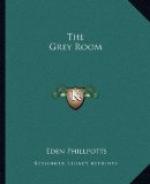Six weeks later letters passed between England and Rome, and Sir Walter wrote to Signor Mannetti, sending such details as he was able to furnish.
“A thin, supple wire was found to run between the harmless flock of the mattress and the satin casing,” wrote Sir Walter. “Experiments showed that neither the stuffing nor the outer case contained any harmful substance. But the wire, of which fifty miles wound over the upper and lower surfaces of the mattress under its satin upholstery, proved infinitely sensitive to heat, and gave off, or ejected at tremendous speed, an invisible, highly poisonous matter even at a lower temperature than that of a normal human being. Insects placed upon it perished in the course of a few hours, and it destroyed microscopic life and fish and frogs in water at comparatively low temperatures, that caused the living organisms no inconvenience until portions of the wire were introduced. A cat died in eight minutes; a monkey in ten. No pain or discomfort marked the operation of the wire on unconscious creatures. They sank into death as into sudden sleep, and examination revealed no physical effects whatever. The wire is an alloy, and the constituent metals have not yet been determined; but it is not an amalgam, for mercury is absent. The wire contains thallium and helium as the spectroscope shows; but its awful radioactivity and deadly emanation has yet to be explained. The chemical experts have a startling theory. They suspect there is a new element here—probably destined to occupy one of the last unfilled places of the Periodic Table, which chronicles all the elements known to science. Chemical analysis fails to reach the radio-active properties, and for their examination the electroscope and spinthariscope are needful. With these the radio-chemists are at work. The wire melted at a lower temperature than lead, but melting did not destroy its potency. After cooling, the metal retained its properties and was still responsive, as before, to warmth. But experiment shows that in a molten state, the metal of the wire increases in effect, and any living thing brought within a yard of it under this condition succumbs instantly. Its properties cannot be extracted, so far, from the actual composition of the wire. They prove also that the emanation from the warmed wire is exceedingly subtle, tenuous, and volatile. Save under conditions of super-heat, it only operates at two feet and a few inches, and the wire naturally grows cold very quickly. It is almost as light as aluminium. A gas mask does not arrest the poison; indeed, it evidently enters a body through the nearest point offered to it and a safe shield has not yet been discovered.
“I shall tell you more when we know more,” concluded Sir Walter. “But at present it looks as though your prophecy were correct, and that science is not going to get at the bottom of the horrible secret easily. Dr. Mannering says that the properties of the elements have yet to be fully determined, while the subject of alloys was never suspected of containing such secrets as may prove to be the case. If more there is to learn, you shall learn it.”




